Digital Resources: Transforming Learning in Arts Education
VerifiedAdded on 2021/02/21
|6
|1612
|194
Report
AI Summary
This report explores the integration of digital resources within arts education, focusing on their impact on learning outcomes, particularly for primary-level students. It details a learning scenario where digital tools enhance pronunciation, communication, and creative thinking. The report identifies suitable age groups (3-8 years) and discusses how resources can be introduced in classrooms and homes, including accommodations for students with special needs. It emphasizes the strong association with the curriculum, especially in subjects like environmental and basic science, and concludes that digital resources foster confidence, creativity, and advanced understanding among learners. Desklib offers additional resources like past papers and solved assignments for students.
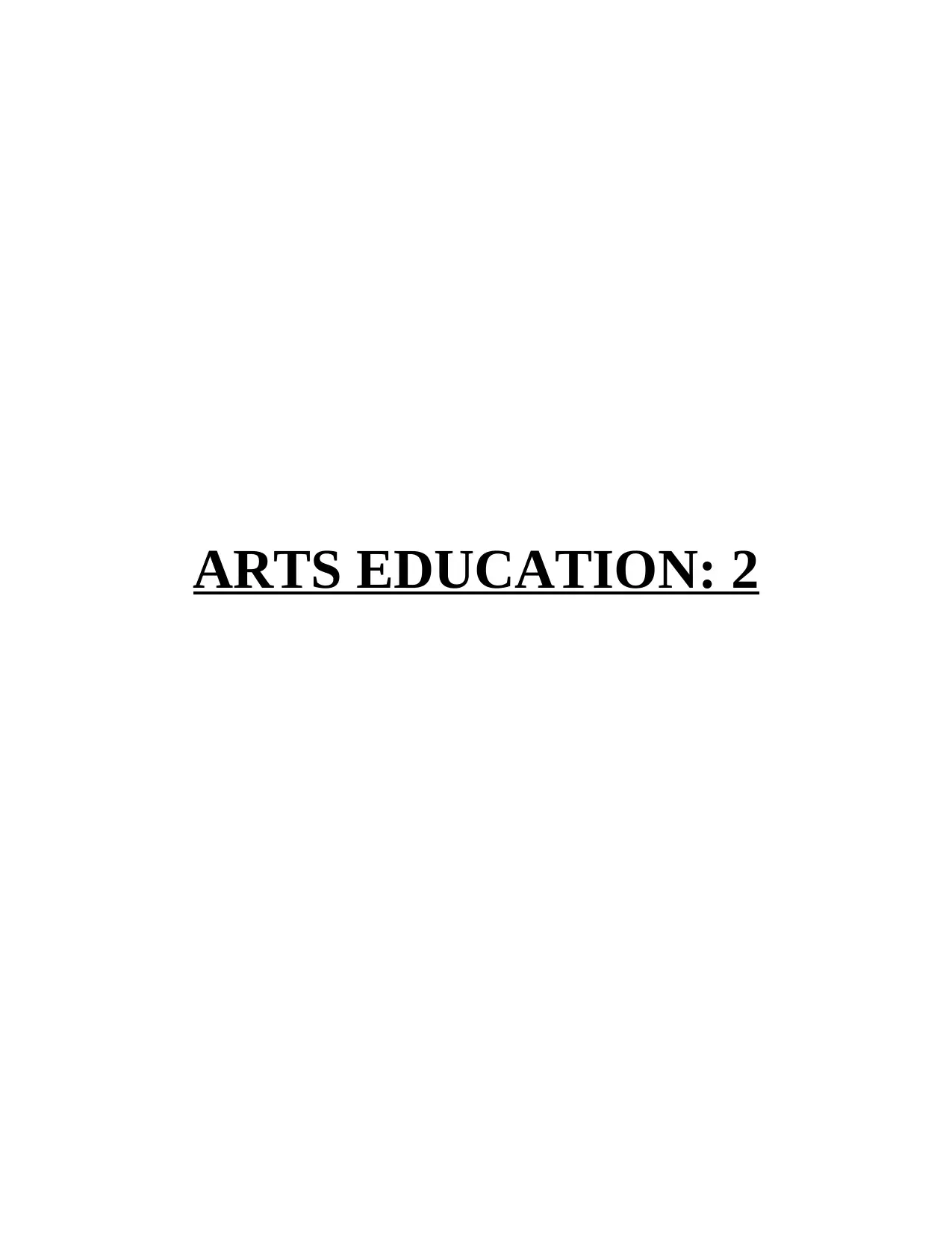
ARTS EDUCATION: 2
Paraphrase This Document
Need a fresh take? Get an instant paraphrase of this document with our AI Paraphraser
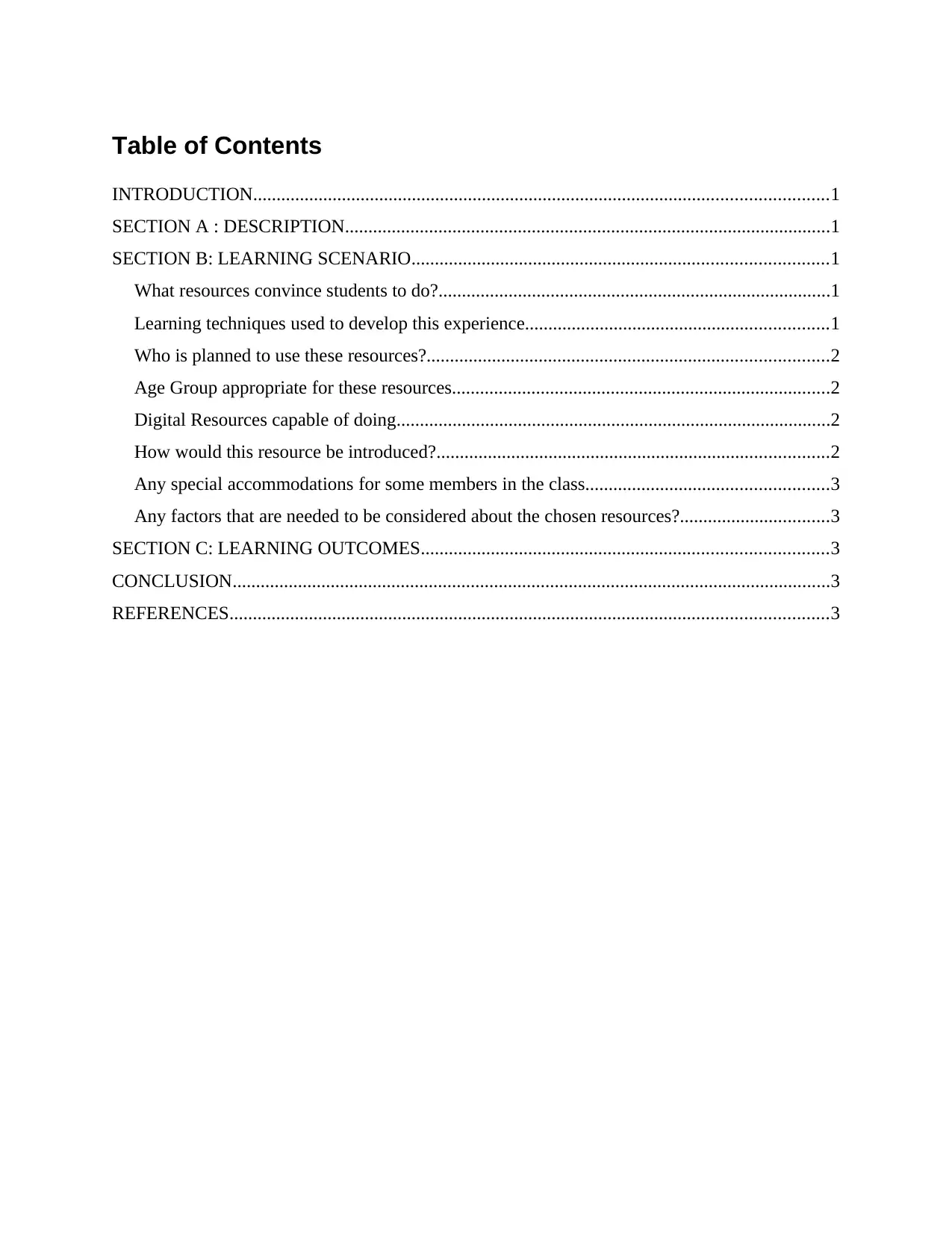
Table of Contents
INTRODUCTION...........................................................................................................................1
SECTION A : DESCRIPTION........................................................................................................1
SECTION B: LEARNING SCENARIO.........................................................................................1
What resources convince students to do?....................................................................................1
Learning techniques used to develop this experience.................................................................1
Who is planned to use these resources?......................................................................................2
Age Group appropriate for these resources.................................................................................2
Digital Resources capable of doing.............................................................................................2
How would this resource be introduced?....................................................................................2
Any special accommodations for some members in the class....................................................3
Any factors that are needed to be considered about the chosen resources?................................3
SECTION C: LEARNING OUTCOMES.......................................................................................3
CONCLUSION................................................................................................................................3
REFERENCES................................................................................................................................3
INTRODUCTION...........................................................................................................................1
SECTION A : DESCRIPTION........................................................................................................1
SECTION B: LEARNING SCENARIO.........................................................................................1
What resources convince students to do?....................................................................................1
Learning techniques used to develop this experience.................................................................1
Who is planned to use these resources?......................................................................................2
Age Group appropriate for these resources.................................................................................2
Digital Resources capable of doing.............................................................................................2
How would this resource be introduced?....................................................................................2
Any special accommodations for some members in the class....................................................3
Any factors that are needed to be considered about the chosen resources?................................3
SECTION C: LEARNING OUTCOMES.......................................................................................3
CONCLUSION................................................................................................................................3
REFERENCES................................................................................................................................3
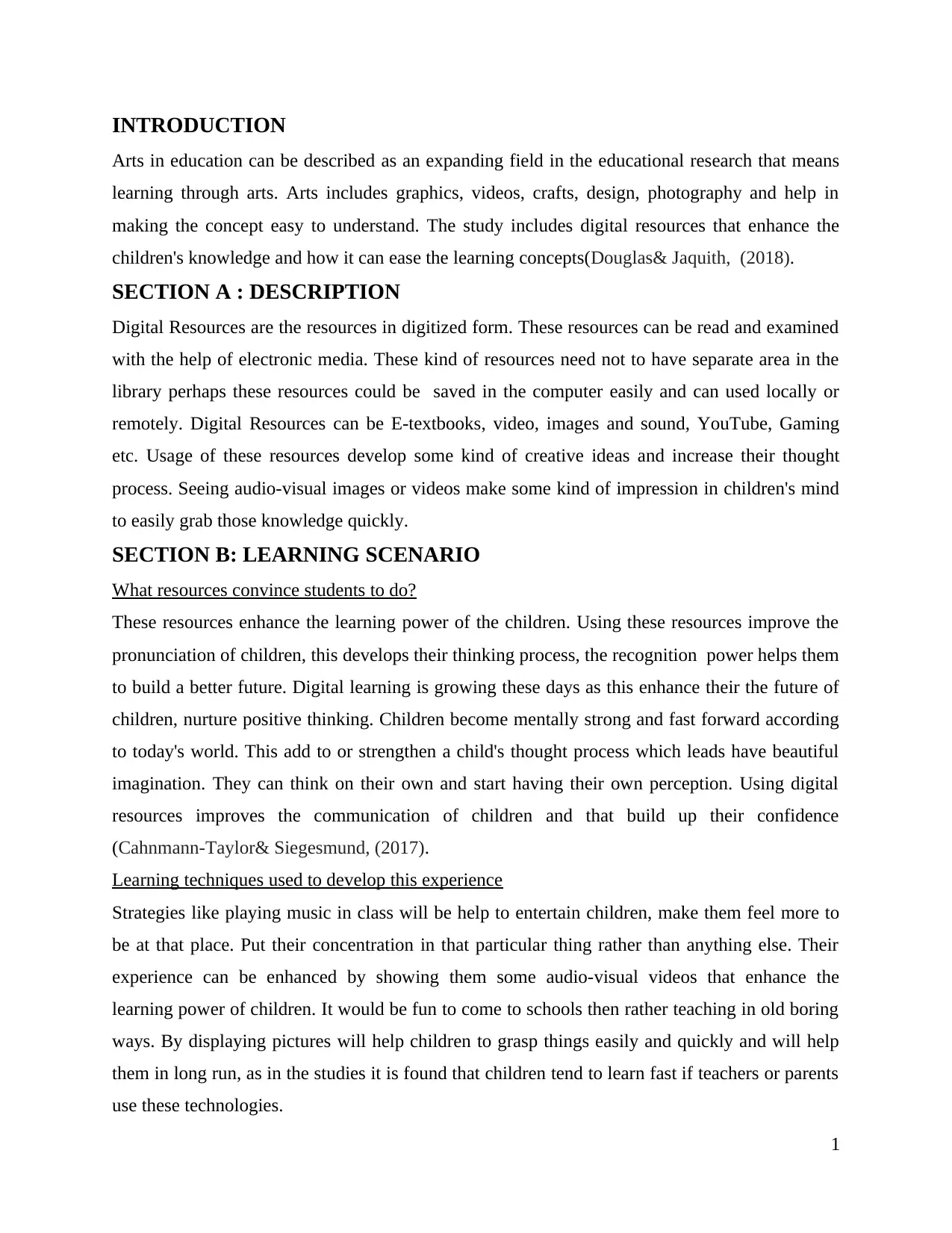
INTRODUCTION
Arts in education can be described as an expanding field in the educational research that means
learning through arts. Arts includes graphics, videos, crafts, design, photography and help in
making the concept easy to understand. The study includes digital resources that enhance the
children's knowledge and how it can ease the learning concepts(Douglas& Jaquith, (2018).
SECTION A : DESCRIPTION
Digital Resources are the resources in digitized form. These resources can be read and examined
with the help of electronic media. These kind of resources need not to have separate area in the
library perhaps these resources could be saved in the computer easily and can used locally or
remotely. Digital Resources can be E-textbooks, video, images and sound, YouTube, Gaming
etc. Usage of these resources develop some kind of creative ideas and increase their thought
process. Seeing audio-visual images or videos make some kind of impression in children's mind
to easily grab those knowledge quickly.
SECTION B: LEARNING SCENARIO
What resources convince students to do?
These resources enhance the learning power of the children. Using these resources improve the
pronunciation of children, this develops their thinking process, the recognition power helps them
to build a better future. Digital learning is growing these days as this enhance their the future of
children, nurture positive thinking. Children become mentally strong and fast forward according
to today's world. This add to or strengthen a child's thought process which leads have beautiful
imagination. They can think on their own and start having their own perception. Using digital
resources improves the communication of children and that build up their confidence
(Cahnmann-Taylor& Siegesmund, (2017).
Learning techniques used to develop this experience
Strategies like playing music in class will be help to entertain children, make them feel more to
be at that place. Put their concentration in that particular thing rather than anything else. Their
experience can be enhanced by showing them some audio-visual videos that enhance the
learning power of children. It would be fun to come to schools then rather teaching in old boring
ways. By displaying pictures will help children to grasp things easily and quickly and will help
them in long run, as in the studies it is found that children tend to learn fast if teachers or parents
use these technologies.
1
Arts in education can be described as an expanding field in the educational research that means
learning through arts. Arts includes graphics, videos, crafts, design, photography and help in
making the concept easy to understand. The study includes digital resources that enhance the
children's knowledge and how it can ease the learning concepts(Douglas& Jaquith, (2018).
SECTION A : DESCRIPTION
Digital Resources are the resources in digitized form. These resources can be read and examined
with the help of electronic media. These kind of resources need not to have separate area in the
library perhaps these resources could be saved in the computer easily and can used locally or
remotely. Digital Resources can be E-textbooks, video, images and sound, YouTube, Gaming
etc. Usage of these resources develop some kind of creative ideas and increase their thought
process. Seeing audio-visual images or videos make some kind of impression in children's mind
to easily grab those knowledge quickly.
SECTION B: LEARNING SCENARIO
What resources convince students to do?
These resources enhance the learning power of the children. Using these resources improve the
pronunciation of children, this develops their thinking process, the recognition power helps them
to build a better future. Digital learning is growing these days as this enhance their the future of
children, nurture positive thinking. Children become mentally strong and fast forward according
to today's world. This add to or strengthen a child's thought process which leads have beautiful
imagination. They can think on their own and start having their own perception. Using digital
resources improves the communication of children and that build up their confidence
(Cahnmann-Taylor& Siegesmund, (2017).
Learning techniques used to develop this experience
Strategies like playing music in class will be help to entertain children, make them feel more to
be at that place. Put their concentration in that particular thing rather than anything else. Their
experience can be enhanced by showing them some audio-visual videos that enhance the
learning power of children. It would be fun to come to schools then rather teaching in old boring
ways. By displaying pictures will help children to grasp things easily and quickly and will help
them in long run, as in the studies it is found that children tend to learn fast if teachers or parents
use these technologies.
1
⊘ This is a preview!⊘
Do you want full access?
Subscribe today to unlock all pages.

Trusted by 1+ million students worldwide
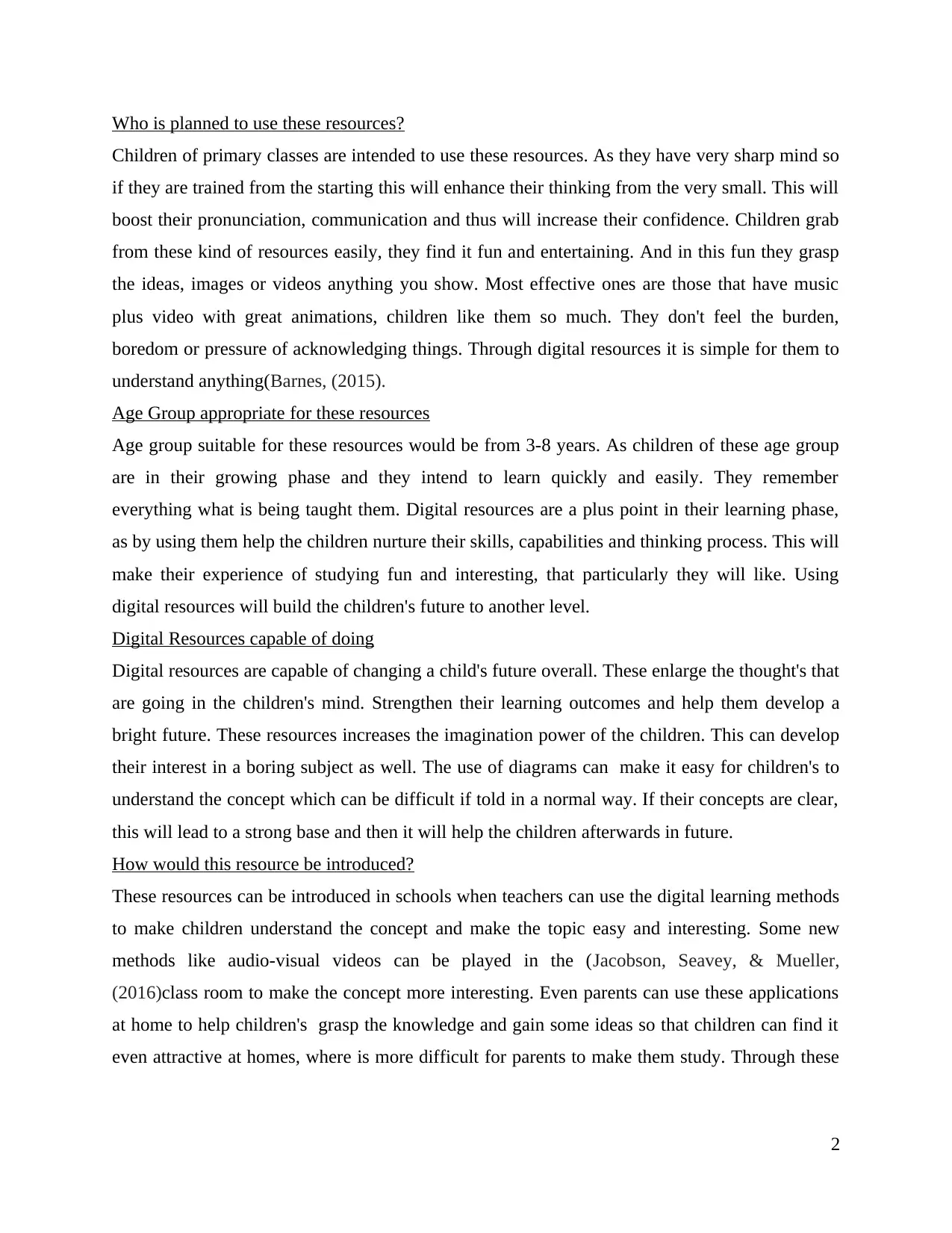
Who is planned to use these resources?
Children of primary classes are intended to use these resources. As they have very sharp mind so
if they are trained from the starting this will enhance their thinking from the very small. This will
boost their pronunciation, communication and thus will increase their confidence. Children grab
from these kind of resources easily, they find it fun and entertaining. And in this fun they grasp
the ideas, images or videos anything you show. Most effective ones are those that have music
plus video with great animations, children like them so much. They don't feel the burden,
boredom or pressure of acknowledging things. Through digital resources it is simple for them to
understand anything(Barnes, (2015).
Age Group appropriate for these resources
Age group suitable for these resources would be from 3-8 years. As children of these age group
are in their growing phase and they intend to learn quickly and easily. They remember
everything what is being taught them. Digital resources are a plus point in their learning phase,
as by using them help the children nurture their skills, capabilities and thinking process. This will
make their experience of studying fun and interesting, that particularly they will like. Using
digital resources will build the children's future to another level.
Digital Resources capable of doing
Digital resources are capable of changing a child's future overall. These enlarge the thought's that
are going in the children's mind. Strengthen their learning outcomes and help them develop a
bright future. These resources increases the imagination power of the children. This can develop
their interest in a boring subject as well. The use of diagrams can make it easy for children's to
understand the concept which can be difficult if told in a normal way. If their concepts are clear,
this will lead to a strong base and then it will help the children afterwards in future.
How would this resource be introduced?
These resources can be introduced in schools when teachers can use the digital learning methods
to make children understand the concept and make the topic easy and interesting. Some new
methods like audio-visual videos can be played in the (Jacobson, Seavey, & Mueller,
(2016)class room to make the concept more interesting. Even parents can use these applications
at home to help children's grasp the knowledge and gain some ideas so that children can find it
even attractive at homes, where is more difficult for parents to make them study. Through these
2
Children of primary classes are intended to use these resources. As they have very sharp mind so
if they are trained from the starting this will enhance their thinking from the very small. This will
boost their pronunciation, communication and thus will increase their confidence. Children grab
from these kind of resources easily, they find it fun and entertaining. And in this fun they grasp
the ideas, images or videos anything you show. Most effective ones are those that have music
plus video with great animations, children like them so much. They don't feel the burden,
boredom or pressure of acknowledging things. Through digital resources it is simple for them to
understand anything(Barnes, (2015).
Age Group appropriate for these resources
Age group suitable for these resources would be from 3-8 years. As children of these age group
are in their growing phase and they intend to learn quickly and easily. They remember
everything what is being taught them. Digital resources are a plus point in their learning phase,
as by using them help the children nurture their skills, capabilities and thinking process. This will
make their experience of studying fun and interesting, that particularly they will like. Using
digital resources will build the children's future to another level.
Digital Resources capable of doing
Digital resources are capable of changing a child's future overall. These enlarge the thought's that
are going in the children's mind. Strengthen their learning outcomes and help them develop a
bright future. These resources increases the imagination power of the children. This can develop
their interest in a boring subject as well. The use of diagrams can make it easy for children's to
understand the concept which can be difficult if told in a normal way. If their concepts are clear,
this will lead to a strong base and then it will help the children afterwards in future.
How would this resource be introduced?
These resources can be introduced in schools when teachers can use the digital learning methods
to make children understand the concept and make the topic easy and interesting. Some new
methods like audio-visual videos can be played in the (Jacobson, Seavey, & Mueller,
(2016)class room to make the concept more interesting. Even parents can use these applications
at home to help children's grasp the knowledge and gain some ideas so that children can find it
even attractive at homes, where is more difficult for parents to make them study. Through these
2
Paraphrase This Document
Need a fresh take? Get an instant paraphrase of this document with our AI Paraphraser
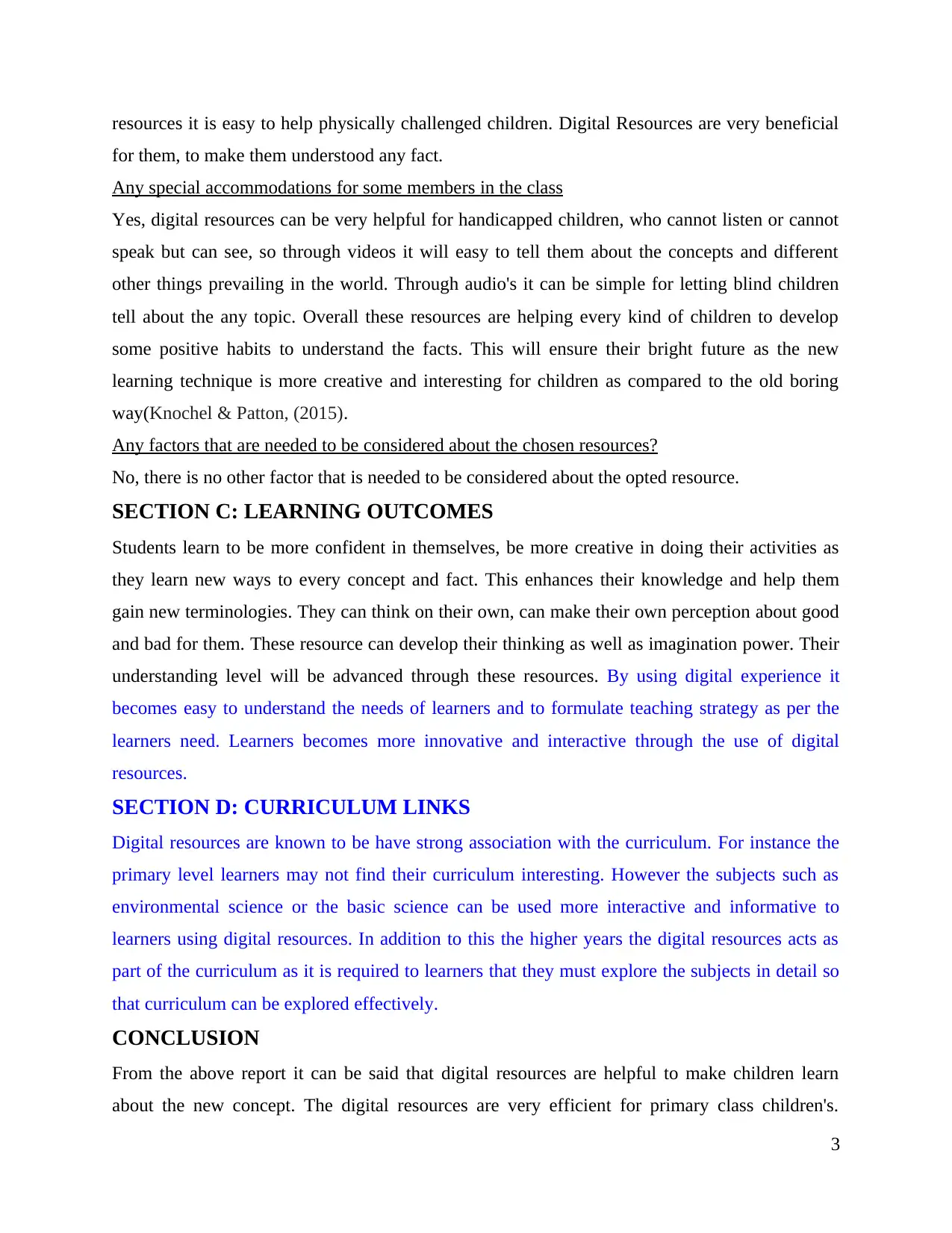
resources it is easy to help physically challenged children. Digital Resources are very beneficial
for them, to make them understood any fact.
Any special accommodations for some members in the class
Yes, digital resources can be very helpful for handicapped children, who cannot listen or cannot
speak but can see, so through videos it will easy to tell them about the concepts and different
other things prevailing in the world. Through audio's it can be simple for letting blind children
tell about the any topic. Overall these resources are helping every kind of children to develop
some positive habits to understand the facts. This will ensure their bright future as the new
learning technique is more creative and interesting for children as compared to the old boring
way(Knochel & Patton, (2015).
Any factors that are needed to be considered about the chosen resources?
No, there is no other factor that is needed to be considered about the opted resource.
SECTION C: LEARNING OUTCOMES
Students learn to be more confident in themselves, be more creative in doing their activities as
they learn new ways to every concept and fact. This enhances their knowledge and help them
gain new terminologies. They can think on their own, can make their own perception about good
and bad for them. These resource can develop their thinking as well as imagination power. Their
understanding level will be advanced through these resources. By using digital experience it
becomes easy to understand the needs of learners and to formulate teaching strategy as per the
learners need. Learners becomes more innovative and interactive through the use of digital
resources.
SECTION D: CURRICULUM LINKS
Digital resources are known to be have strong association with the curriculum. For instance the
primary level learners may not find their curriculum interesting. However the subjects such as
environmental science or the basic science can be used more interactive and informative to
learners using digital resources. In addition to this the higher years the digital resources acts as
part of the curriculum as it is required to learners that they must explore the subjects in detail so
that curriculum can be explored effectively.
CONCLUSION
From the above report it can be said that digital resources are helpful to make children learn
about the new concept. The digital resources are very efficient for primary class children's.
3
for them, to make them understood any fact.
Any special accommodations for some members in the class
Yes, digital resources can be very helpful for handicapped children, who cannot listen or cannot
speak but can see, so through videos it will easy to tell them about the concepts and different
other things prevailing in the world. Through audio's it can be simple for letting blind children
tell about the any topic. Overall these resources are helping every kind of children to develop
some positive habits to understand the facts. This will ensure their bright future as the new
learning technique is more creative and interesting for children as compared to the old boring
way(Knochel & Patton, (2015).
Any factors that are needed to be considered about the chosen resources?
No, there is no other factor that is needed to be considered about the opted resource.
SECTION C: LEARNING OUTCOMES
Students learn to be more confident in themselves, be more creative in doing their activities as
they learn new ways to every concept and fact. This enhances their knowledge and help them
gain new terminologies. They can think on their own, can make their own perception about good
and bad for them. These resource can develop their thinking as well as imagination power. Their
understanding level will be advanced through these resources. By using digital experience it
becomes easy to understand the needs of learners and to formulate teaching strategy as per the
learners need. Learners becomes more innovative and interactive through the use of digital
resources.
SECTION D: CURRICULUM LINKS
Digital resources are known to be have strong association with the curriculum. For instance the
primary level learners may not find their curriculum interesting. However the subjects such as
environmental science or the basic science can be used more interactive and informative to
learners using digital resources. In addition to this the higher years the digital resources acts as
part of the curriculum as it is required to learners that they must explore the subjects in detail so
that curriculum can be explored effectively.
CONCLUSION
From the above report it can be said that digital resources are helpful to make children learn
about the new concept. The digital resources are very efficient for primary class children's.
3
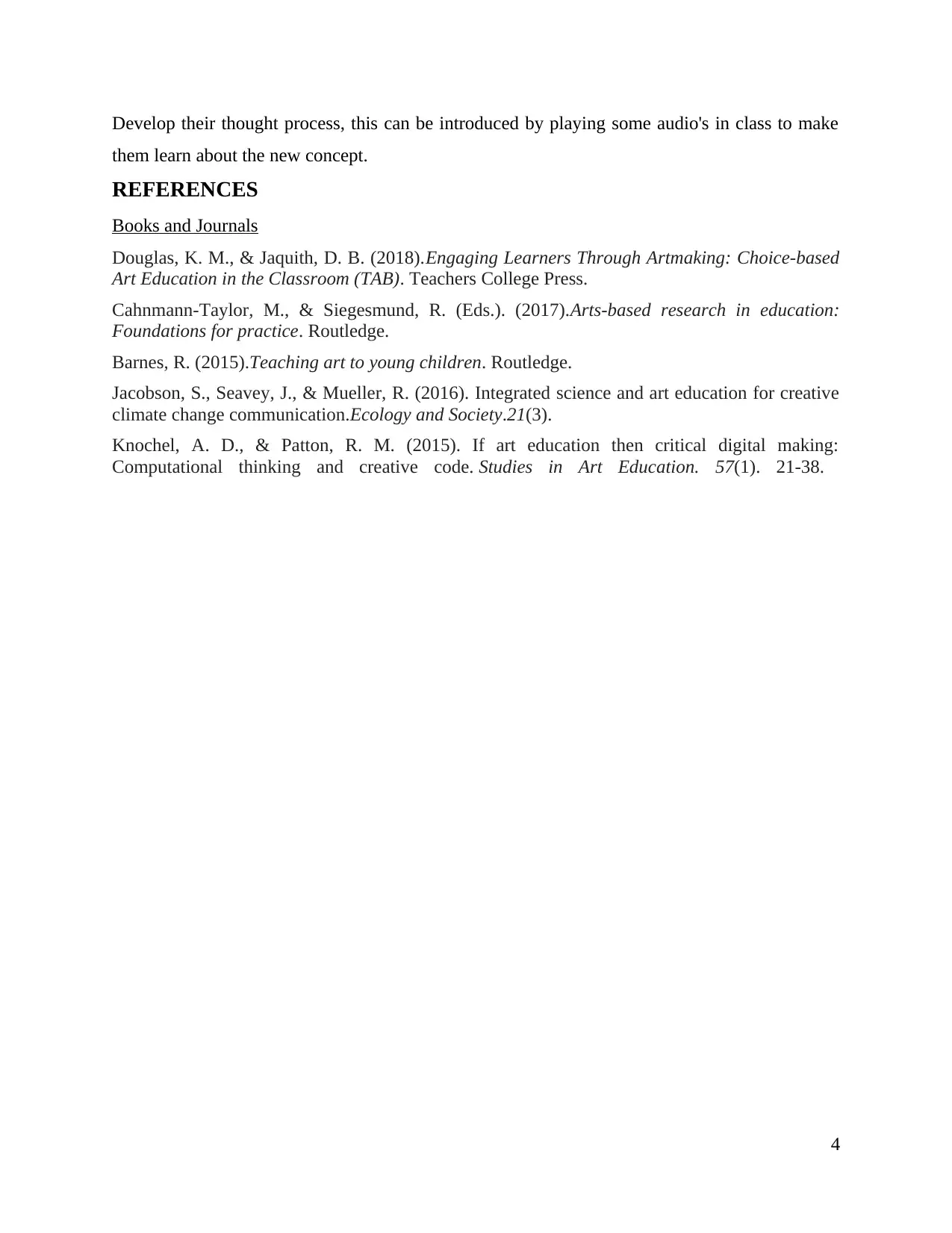
Develop their thought process, this can be introduced by playing some audio's in class to make
them learn about the new concept.
REFERENCES
Books and Journals
Douglas, K. M., & Jaquith, D. B. (2018).Engaging Learners Through Artmaking: Choice-based
Art Education in the Classroom (TAB). Teachers College Press.
Cahnmann-Taylor, M., & Siegesmund, R. (Eds.). (2017).Arts-based research in education:
Foundations for practice. Routledge.
Barnes, R. (2015).Teaching art to young children. Routledge.
Jacobson, S., Seavey, J., & Mueller, R. (2016). Integrated science and art education for creative
climate change communication.Ecology and Society.21(3).
Knochel, A. D., & Patton, R. M. (2015). If art education then critical digital making:
Computational thinking and creative code. Studies in Art Education. 57(1). 21-38.
4
them learn about the new concept.
REFERENCES
Books and Journals
Douglas, K. M., & Jaquith, D. B. (2018).Engaging Learners Through Artmaking: Choice-based
Art Education in the Classroom (TAB). Teachers College Press.
Cahnmann-Taylor, M., & Siegesmund, R. (Eds.). (2017).Arts-based research in education:
Foundations for practice. Routledge.
Barnes, R. (2015).Teaching art to young children. Routledge.
Jacobson, S., Seavey, J., & Mueller, R. (2016). Integrated science and art education for creative
climate change communication.Ecology and Society.21(3).
Knochel, A. D., & Patton, R. M. (2015). If art education then critical digital making:
Computational thinking and creative code. Studies in Art Education. 57(1). 21-38.
4
⊘ This is a preview!⊘
Do you want full access?
Subscribe today to unlock all pages.

Trusted by 1+ million students worldwide
1 out of 6
Related Documents
Your All-in-One AI-Powered Toolkit for Academic Success.
+13062052269
info@desklib.com
Available 24*7 on WhatsApp / Email
![[object Object]](/_next/static/media/star-bottom.7253800d.svg)
Unlock your academic potential
Copyright © 2020–2025 A2Z Services. All Rights Reserved. Developed and managed by ZUCOL.





